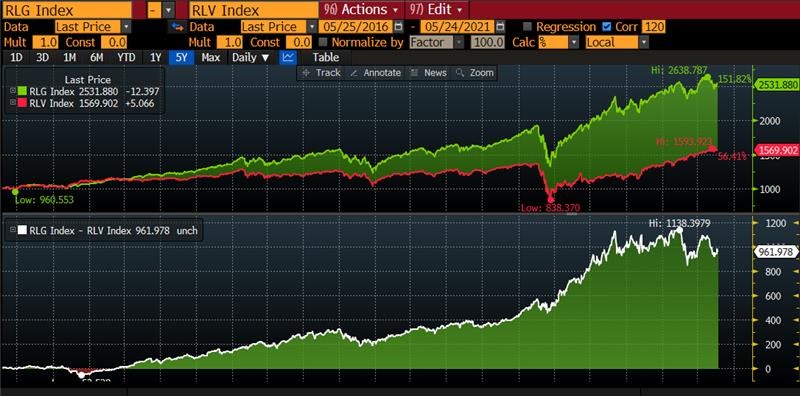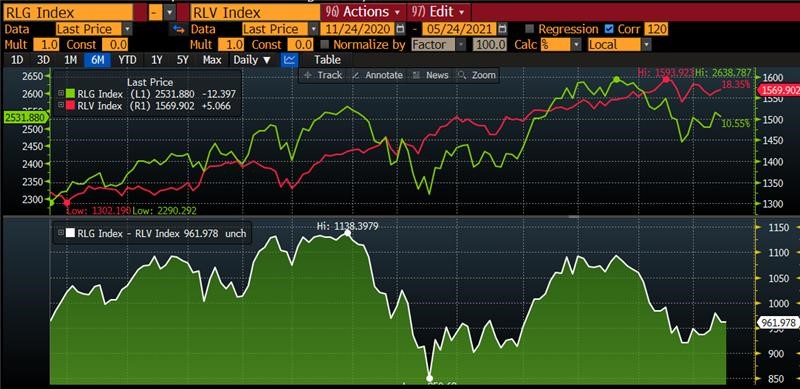When Max wrote his morning note regarding Private Equity investment last week, we had a discussion around the desks that border our equity and fixed income trading teams about what constitutes an asset class, and whether private equity is an asset class onto itself.
The answer is that it isn’t, because an asset class is defined as:
“a stable aggregation of investable units that is internally homogeneous and externally heterogeneous, that when added to a portfolio raises its expected utility without the benefit of selection skill and can be accessed cost effectively in size.”
[Turkington, Kinlaw, Kritzman, (2017)]
Whereby private equity is not externally heterogeneous from other domestic equities and invalidates the selection skill criterium, as private equity requires a high degree of skill to assess manager competency.
This discussion begged the question, therefore what are the FACTORS rather than management STYLES that are driving asset classes this year, in a year where we’re speaking about “value”, “growth”, “momentum” and “small cap equities” more and more.
Background on Factors
In the early 1980s, technological advances in computing from IBM and others led to the first market index funds (“mutual funds”), where Russell introduced the Russell 2000 Index, the world’s first small cap benchmark.
Due to its popularity, it soon after introduced the first growth and value style indexes, where the factors of size, growth and value were known as “style boxes” that affected the way investors constructed portfolios for the years to come.
However, factors remained the realm of quantitative analysis until the 2010s, where even ten years ago it would’ve been unheard of to have discussions with retail clients regarding growth, value or momentum styles, in detail.
Fast forward to today, and we’re talking about these factors in every conversation as they’ve become mainstream knowledge.
What are Factors?
Factors are labels that reflect exposure to a source of risk and are not directly investable.
Moreover, the composition of a collection of assets designed to replicate them is unstable and requires periodic or regular rebalancing of the replicating assets.
Due to the rise in popularity of indexing and ETF products, this has made factors-based investments more accessible across the globe, rather than via managed funds, where an every-day investor has access through a simple retail equity trading account.
Why Focus on Factors?
The idea behind factor-based investing is that we’re seeking to gain exposure to risk and return factors that are driving markets.
For example, we compare the performance of the Russell Growth Index (green line) versus the Russell Value index (red line) and the differential of their performance (bottom panel).
Over the past five years, the Growth index has rallied 151.82% while the Value index has returned 56.41%, a clear outperformance by Growth.

However, if we refine out time period to the last six months, Growth has returned 10.55%, whereas Value has returned 18.35%. This is largely due to perception, where value factors are perceived to be relatively safe compared to growth in a rising bond yield environment, and in general, growth equities have more sensitivity to interest rates and borrowing costs.

Factors vs Style
At this point we need to differentiate a common misunderstanding between factor-based investments and manager styles.
“Style” is a concept that represents broader market segments based on the professional managers that invest in these markets, to varying styles.
Within this category features style segments such as active or passive management, small/medium/large cap investing, buy-and-hold or higher turn-over/active etc.
For example:
| Factors | Styles | |
| Market Coverage | Focused exposure to stocks with high capture to one targeted factor | Broad exposure to sets of characteristics |
| One sided subset of a market segment, i.e. high momentum | Splits market segments into two-sided components i.e. value vs growth or ESG-non-ESG | |
| Factor Capture | High factor capture | Moderate factor capture |
| Significant exposure to targeted factors | Moderate tilt towards factor characteristics | |
| Weighting | Factor-weighted | Market cap weighted |
| Turnover | Periodic: quarterly, semi-annual etc | Annual reconstitution |
| High turn-over | Low turnover | |
| Active/Passive | Higher activity | Lower active share |
| Broader subset of parent index |
List of Factors
There are many factors that we can derive to try and capture factor-based outperformance of markets.
For the last thirty years, the following factors have remained relevant:
- Value – Assets priced at discounts relative to their fundamental values may outperform
- Growth – Asset forecast to increase earnings at an above-average rate
- Momentum – Past winners should continue to be winners, whilst losers will continue to be losers
- Quality – Assets issued by firms with strong fundamentals may outperform over business cycles. This is increasingly relevant due to the rise in popularity of ESG
- Market Cap Size – Assets of a specific market capitalization may outperform other market capitalisations. For example, large and mega cap equities outperformed in 2020 due to their capital market access and corporate footprint, where they were quicker to receive government support compared to smaller companies
- Volatility – Assets that are considered high or low volatility can have perceived higher or lower risk-adjusted returns
Where to From Here for Factors?
The trillion-dollar question.
Correctly forecasting what factors are going to be the primary drivers of financial markets is a matter of importance for investors – who may get their asset allocation in place appropriately for their client base but underperform because they were not positively exposed to the correct factors.
The case in point has been the factor rotation from growth to value equities, with a clear outperformance by value style factors, which we expect to continue as markets factor in higher borrowing costs due to higher government bond yields.
This is in contrast to factors such as quality and momentum, where a combination of the two is likely to benefit from the quality companies receiving increased asset allocation due to ESG-style investment; but also due to those increasing their ESG-rating with positive momentum factors as well.
Closing Remarks
This is clearly a very broad topic that we can’t possibly cover within one note and approximately 1000 words.
This is why we’re going to publish several other notes in the coming week regarding growth, value, quality, momentum factors and how investors can access these factors and potentially attain the isolated drivers of outperformance.
The views expressed in this article are the views of the stated author as at the date published and are subject to change based on markets and other conditions. Past performance is not a reliable indicator of future performance. Mason Stevens is only providing general advice in providing this information. You should consider this information, along with all your other investments and strategies when assessing the appropriateness of the information to your individual circumstances. Mason Stevens and its associates and their respective directors and other staff each declare that they may hold interests in securities and/or earn fees or other benefits from transactions arising as a result of information contained in this article.



